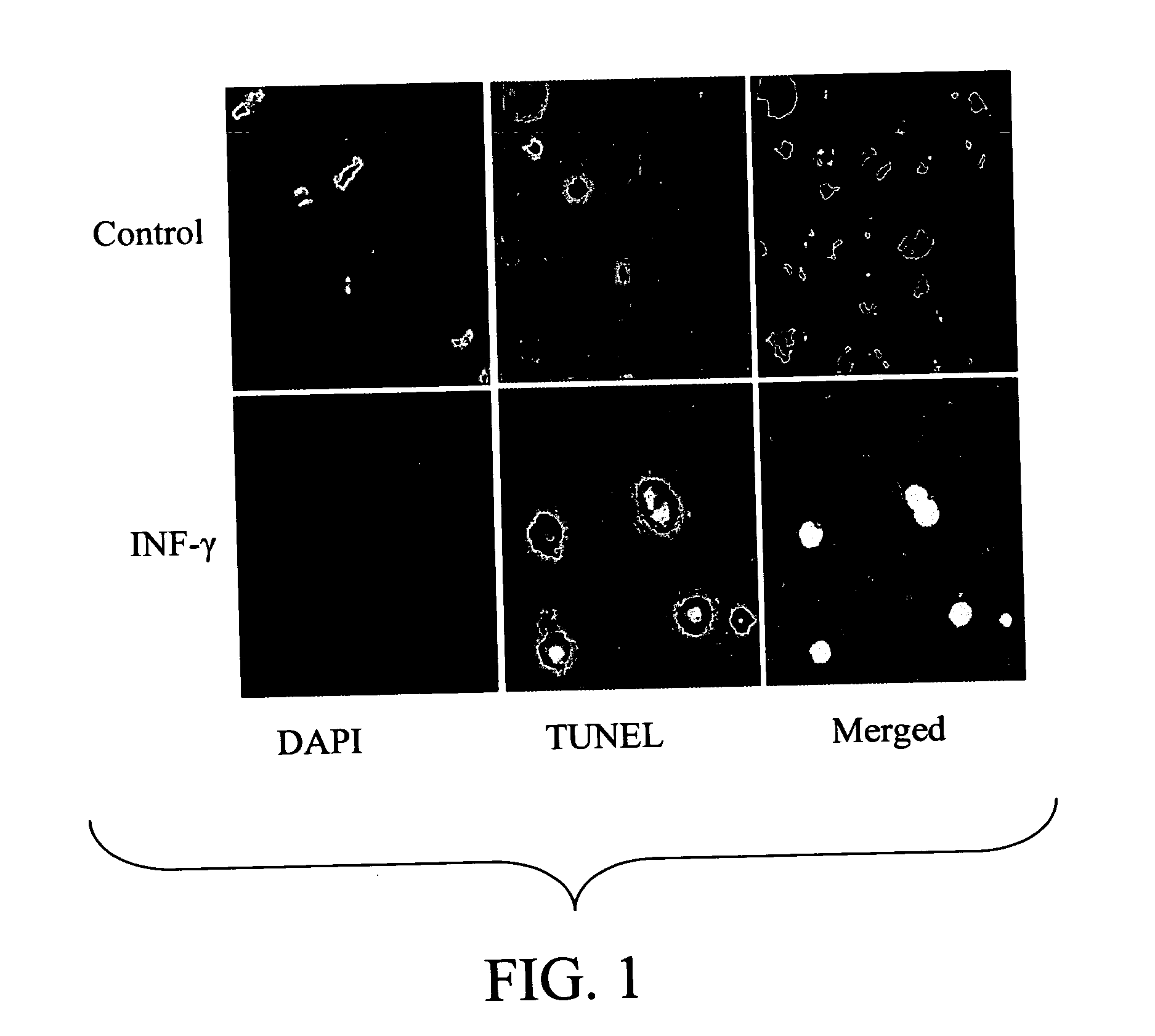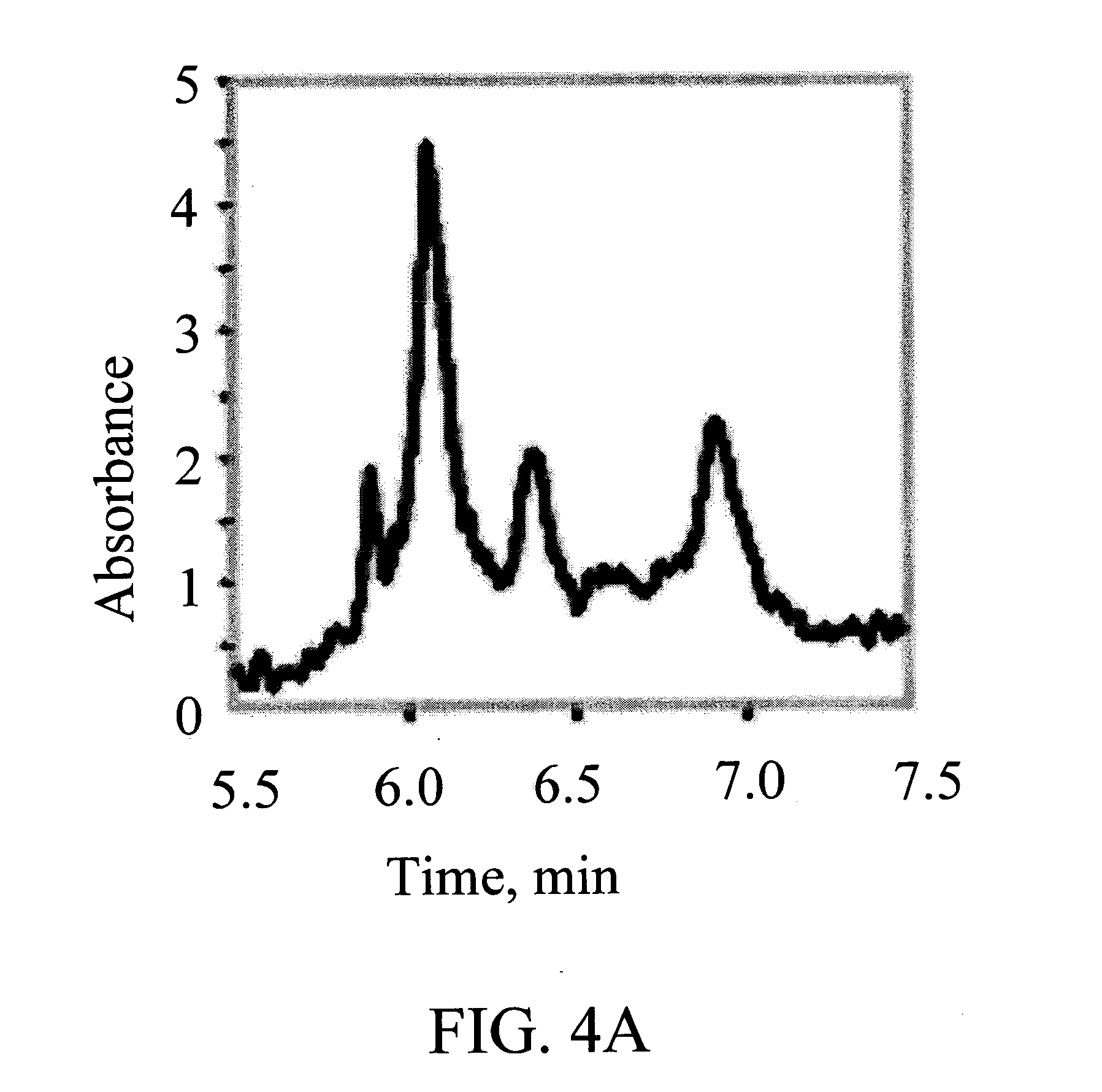Nanogene therapy for cell proliferation disorders
a cell proliferation and neoplasm technology, applied in the direction of genetic material ingredients, drug compositions, peptide/protein ingredients, etc., can solve the problems of aggressive cancers that are difficult to treat, disease remains difficult to effectively treat, and their long-term survival is poor, so as to reduce (partially or completely inhibit, slow down, slow down) uncontrolled cell growth and reduce cellular growth
- Summary
- Abstract
- Description
- Claims
- Application Information
AI Technical Summary
Benefits of technology
Problems solved by technology
Method used
Image
Examples
example 1
pIFN-γ Induces Apoptosis of HEp-2 Carcinoma Cells
[0145] To determine the effect of overexpression of pIFN-γ on proliferation of A549 lung epithelial cells, cells were transfected with either pIFN-γ or empty vector, pVAX (control). Cell cycle analysis was performed using propidium iodide (PI) staining and flow cytometry 48 hours after transfection. No significant difference was observed between control and pIFN-γ-transfected cells in S1, Go-G1 and G2-M stages of the cell cycle (data not shown). However, an analysis of apoptosis using fluorescence microscopy cells transfected with pIFN-γ exhibited significantly higher apoptosis compared to cells transfected with either the control plasmid or a plasmid encoding pVAX (shown in FIG. 1).
[0146] Cells were seeded into 4-well slide dishes at 104 cells per well and allowed to grow to 75% confluency. Cells were treated for 20 hours with 1000 U / ml IFN-γ. After 24 hours, cells were fixed with 4% paraformaldehyde in PBS for 25 minutes at 4° C. ...
example 2
Microarray Analysis of Chitosan—pIFNgamma Treated Lungs
[0149] Using MU11KsubA and B chips (Affymetrix), which contain probes interrogating about 11,000 murine genes and ESTs (Unigene, Build-4), as well as EST clusters from TIGR (1.0 Beta), we have identified a total of 126 differentially expressed genes whose expression level is altered in the CIN treated mouse lung in the range of −10.6- to 152.4-fold. A noteworthy observation is the up-regulation of the expression of a number of IFN-inducible genes, immune response related genes, and genes involved in signal transduction, including STAT1 and STAT4.
TABLE 1GENE EXPRESSION ANALYSIS INBALB / c LUNG BY MICROARRAYMax. FoldCategory of GenesChangeGenesIFN-regulated12IFN-induced 15 KDa protein,IFN-activable protein 204,Eukaryotic initiation factor5, Mx protein, MIG, IP-10,Interferon regulatory factor(mirf7), interferon-activatableprotein, IFN-induced protein6-16 precursor, IFN-inducedguanylate-binding protein,HLA-associated protein i(phap...
example 3
Chitosan-Conjugated pIFN-γ Plasmid Prevents Metastasis of Lung Tumors in Nude Mice
[0150] BALB / c nude mice were injected intravenously with 5×106 A549 cells, then treated one day afterwards and at weekly intervals with pIFN-γ or control plasmid. After 4 weeks, mice were examined for lung histology. The control animals showed tumors, whereas no tumors were seen in the pIFN-γ-treated group (FIG. 3). These results indicate that pIFN-γ has the potential to decrease tumor metastasis.
[0151] The results indicated in FIG. 3 were obtained when BALB / c nude mice were injected with A549 cells (5×106 cells / mouse) intravenously and one group treated with pIFN-gamma and another group with pVAX as control. The lungs of control mice showed numerous lung nodules in contrast to mice treated with pIFN-gamma, which showed very few tumors. The lungs were removed from mice treated with nanoparticles carrying empty plasmid pVAX (control) or with pIFN-gamma (Rx) and H & E stained. The lungs of control mice...
PUM
| Property | Measurement | Unit |
|---|---|---|
| Atomic weight | aaaaa | aaaaa |
| Atomic weight | aaaaa | aaaaa |
| Atomic weight | aaaaa | aaaaa |
Abstract
Description
Claims
Application Information
 Login to View More
Login to View More - R&D
- Intellectual Property
- Life Sciences
- Materials
- Tech Scout
- Unparalleled Data Quality
- Higher Quality Content
- 60% Fewer Hallucinations
Browse by: Latest US Patents, China's latest patents, Technical Efficacy Thesaurus, Application Domain, Technology Topic, Popular Technical Reports.
© 2025 PatSnap. All rights reserved.Legal|Privacy policy|Modern Slavery Act Transparency Statement|Sitemap|About US| Contact US: help@patsnap.com



